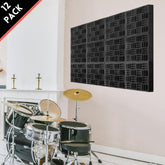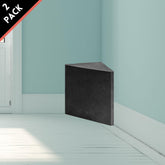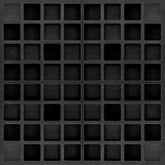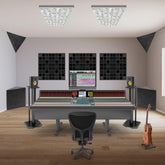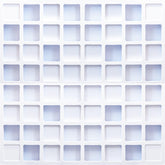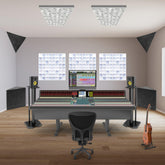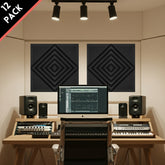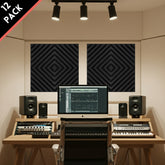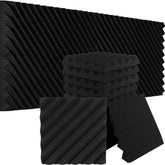Delay Techniques for Adding Depth and Interest
Delay Techniques for Adding Depth and Interest

Understanding Delay
What is Delay?
Delay is an audio effect that records a signal and plays it back after a set period, creating an echo effect. The timing, feedback, and modulation of the delay can be adjusted to achieve various effects, from simple echoes to complex rhythmic patterns.
Basic Parameters of Delay
- Delay Time: The time interval between the original signal and the repeated signal. It’s usually measured in milliseconds (ms).
- Feedback: The amount of the delayed signal that is fed back into the delay unit. Higher feedback settings create more repetitions, resulting in longer echo tails.
- Mix: The balance between the dry (original) signal and the wet (delayed) signal. Adjusting the mix allows you to control how prominent the delay effect is in the mix.
Types of Delay
Analog Delay
Description: Analog delays use bucket-brigade devices (BBD) to create the delay effect. They are known for their warm, organic sound and subtle degradation of the repeated signal.
Applications: Analog delay is often used on guitars, vocals, and synths to add warmth and character.
Digital Delay
Description: Digital delays offer precise control over delay time and feedback, producing clean, clear repeats. They are versatile and can be used in a wide range of applications.
Applications: Digital delay is suitable for creating rhythmic patterns, slapback echoes, and long, clean delay tails.
Tape Delay
Description: Tape delay emulates the sound of vintage tape machines. It is characterized by its warm, saturated sound and the ability to modulate pitch with changes in tape speed.
Applications: Tape delay is ideal for adding warmth and a retro vibe to guitars, vocals, and drums.
Ping-Pong Delay
Description: Ping-pong delay alternates the delayed signal between the left and right channels, creating a bouncing effect across the stereo field.
Applications: Ping-pong delay is great for creating a wide, immersive stereo image and is often used on synths, vocals, and percussive elements.

Creating Depth with Delay
Using Delay for Depth
Delay can be used to create a sense of depth by simulating the natural reflections of sound in a space. Here’s how to use delay for depth:
- Short Delay Times: Use short delay times (20-50 ms) to create a subtle sense of space. This can make elements like vocals or guitars feel more integrated into the mix without using reverb.
- Slapback Delay: A single repeat with a short delay time (80-120 ms) can add thickness to vocals, guitars, and drums, making them stand out in the mix.
- Doubling Effects: Set a delay slightly offset from the original signal (10-30 ms) with minimal feedback to create a doubling effect, adding width and depth to a track.
Delay vs. Reverb for Depth
While both delay and reverb can add depth to a mix, delay offers more control and clarity. Reverb tends to blur the original signal, while delay maintains the distinctness of each repetition, allowing you to add depth without losing clarity.
Adding Rhythmic Interest
Syncing Delay to Tempo
Syncing the delay time to the tempo of your track can create rhythmic echoes that complement the groove of the song. Common settings include:
- Quarter-Note Delay: Produces a delay that repeats every quarter note, creating a strong, rhythmic pulse.
- Eighth-Note Delay: Faster than quarter-note delay, ideal for creating a driving rhythm.
- Dotted Eighth-Note Delay: Creates a syncopated feel, often used on guitars in genres like rock and pop.
Creating Rhythmic Patterns
You can create complex rhythmic patterns by combining multiple delay effects or using delay in conjunction with other effects like panning and modulation. Experiment with different delay times and feedback settings to create unique patterns that enhance the rhythmic structure of your track.
Using Delay on Percussion
Applying delay to percussion elements can add groove and complexity to your rhythm section. For example, adding a short, syncopated delay to a snare drum or hi-hat can create intricate rhythmic textures that make the beat more engaging.
Creative Delay Techniques
Reverse Delay
What is Reverse Delay? Reverse delay plays back the delayed signal in reverse, creating a swelling effect that can be eerie or dramatic.
How to Use It: Apply reverse delay to vocal phrases, guitar riffs, or snare hits to create a rising effect that builds tension before the main sound is heard.
Ducking Delay
What is Ducking Delay? Ducking delay lowers the volume of the delayed signal when the original signal is present, allowing the delay to be more prominent during pauses in the original sound.
How to Use It: Use ducking delay on vocals to keep the delays from cluttering the mix while maintaining clarity during the vocal performance.
Modulated Delay
What is Modulated Delay? Modulated delay adds pitch modulation to the delayed signal, creating a chorus-like effect that can add movement and texture.
How to Use It: Apply modulated delay to synths, pads, or guitars to create a shimmering, evolving sound that adds depth and interest to your mix.
Delay in Different Genres
Rock and Pop
In rock and pop music, delay is often used on guitars and vocals to add depth and rhythmic complexity. Slapback delay is common on vocals for a classic rockabilly sound, while longer delays can create lush, spacious effects on guitars.
Electronic Music
In electronic music, delay is a key tool for creating complex, evolving soundscapes. Syncing delay to the tempo and using modulation effects can add movement and interest to synths, drums, and vocal chops.
Ambient Music
In ambient music, delay is used extensively to create vast, immersive soundscapes. Long delay times with high feedback settings can turn simple sounds into evolving textures that fill the stereo field.
Conclusion
Delay is a versatile and powerful effect that can add depth, interest, and complexity to your mixes. Whether you’re using it to create subtle space or to craft intricate rhythmic patterns, understanding the different types of delay and how to apply them creatively is essential for any sound engineer or producer. Experiment with these techniques to discover new ways to enhance your tracks and create a unique sonic signature.
ABOUT AUTHOR
House Live Engineer of Free Bird, a live house with the history of South Korea's indie music scene.
Single album/Regular album/Live recording, Mixing and Mastering experience of various rock and jazz musicians

